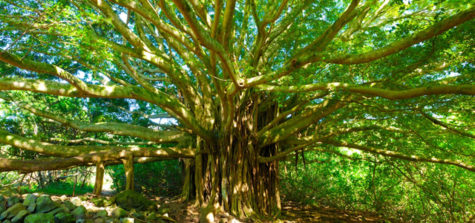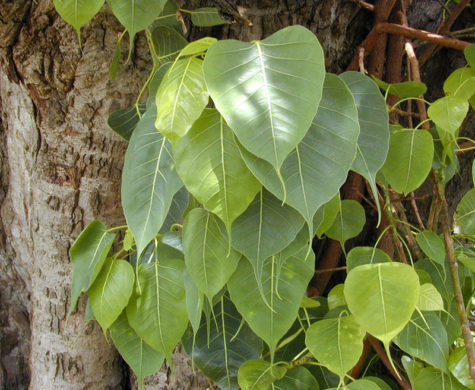The Banyan Tree
The banyan, or Ficus religiosa, is also known as the vata tree, the bodhi tree, or the Asiatic fig, is one of the trees considered to be the World Tree by the people who revere it. It is considered sacred by the followers of Hinduism, Jainism and Buddhism. In the Bhagavad Gita, Krishna says,
“I am the Peepal tree among the trees, Narada among the sages, Chitraaratha among the Gandharvas, And sage Kapila among the Siddhas.”
This tree is particularly special because the Buddha happened to be sitting underneath one when he was suddenly illumined as to his true nature – the word bodhi means “enlightened.” Although the particular tree under which he was enlightened is no longer living, a cutting was taken in the second century BC by a Sri Lankan princess, and this tree now grows in Anuradhapura in Sri Lanka, where it is the object of pilgrimage. Known as Jaya Sri Maha Bodhi, it is the oldest flowering plant in the world.
Not all Ficus religiosa, (or Banyan trees) can be called a Bodhi Tree. A Bodhi Tree must be able to trace its parent to another Bodhi Tree and the line goes on until the first Bodhi Tree under which Gautama is said to have gained enlightenment.
The banyan can be found anywhere in the world where Buddhism or Hinduism are practiced, and it is often grown near temples. Vishnu, the Hindu God, is often depicted as sitting under a banyan dispensing teachings of philosophy and science to his students.
The tree grows in quite an unusual way with its roots reaching down from its branches which then take hold in the ground. This is why the banyan is sometimes called the “walking tree” or the “tree with many feet.”
The structure of the tree, which is a little like a strange organic building that casts a deep shade, makes it a perfect place to meet, and village councils in India (whose national symbol it is) still meet under these trees to discuss important matters.
The leaves of the banyan move continuously even when the air around is still and no perceptible wind is blowing. This phenomenon can be explained due to the long leaf stalk and the broad leaf structure. However, religious minded people in Hindu/Buddhist religion attribute this movement of the leaves to the fact that “devas” or “gods” reside on these leaves and make it move continuously.
Although it is sacred, it is said to shelter many different kinds of spirits, and so it is considered unlucky to sleep under one at night.
Sadhus (Hindu ascetics) still meditate beneath sacred fig trees, and Hindus do pradakshina (circumambulation, or meditative pacing) around the sacred fig tree as a mark of worship. Usually seven pradakshinas are done around the tree in the morning time chanting “vriksha rajaya namah“, meaning “salutation to the king of trees.”
According to Vedic astrology, the 27 stars (constellations) constituting 12 houses (rasis) and 9 planets are specifically and precisely represented by 27 trees—one for each star. The Bodhi Tree is said to represent Pushya (Western star name γ, δ and θ Cancri in the Cancer constellation).
Sources: Wikipedia
And The Element Encyclopedia of Secret Signs and Symbols






Very nice! I am so intrigued by this beautiful tree and I have been for years. After reading this I can see why I felt so drawn to this majestic beautiful piece of nature. I am a florida nativevand they are everywhere! Thank you for the wonderful history of the great Banyan Tree!